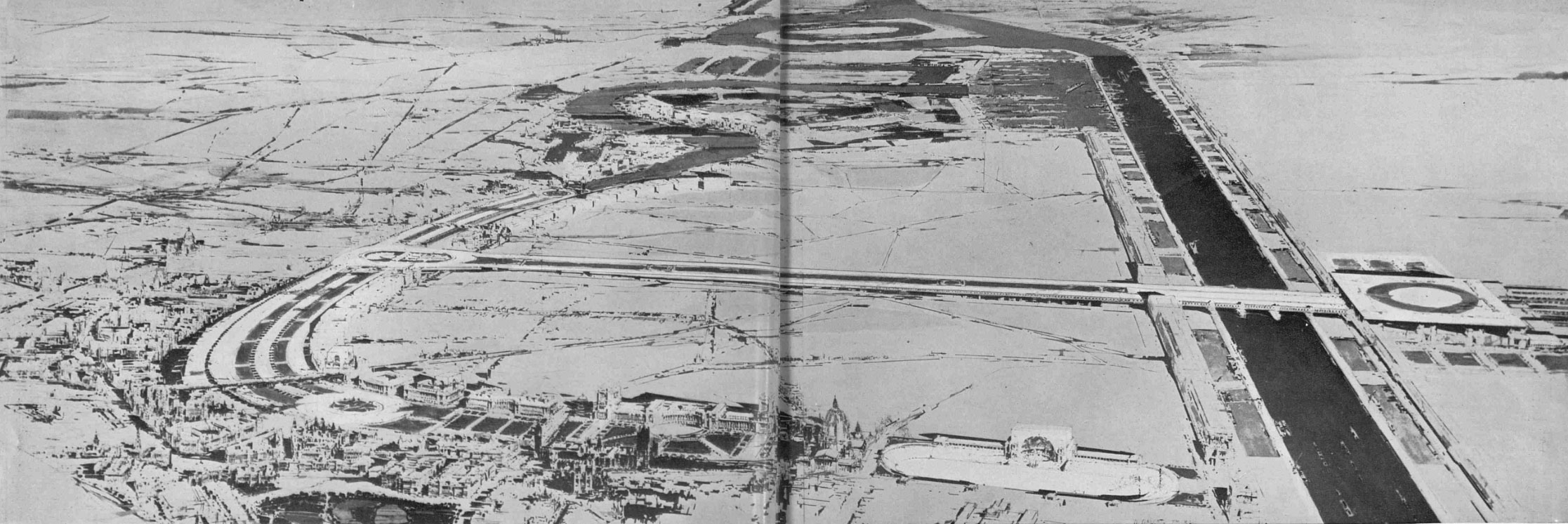The River Thames flows through a very expensive part of London, so wouldn’t it make more sense to divert it somewhere cheap — like South London, and then make better use of the land in central London? That was the proposal in 1933 by the artist-architect, William Walcot.

The Sphere, 7th January 1933. (c) The Illustrated London News. Reproduced from the British Newspaper Archive.
A lot of his motivation was based on creating grandeur — he bemoaned the rising heights of buildings, even though at the time hardly any when above five storeys and worried that people wouldn’t be able to appreciate architecture, because the couldn’t stand far enough back from it to see the whole building.
Noting — accurately at the time — that Londoners had turned their backs on the Thames he felt there was an opportunity to make better use of the space the Thames occupied.
If the Thames were somewhere else, then what was once the Thames could become a Grand Boulevard through the heart of the city. The factories and warehouses that lined the south bank of the Thames would be replaced with equally grand buildings befitting such a scheme. The advantage of such a wide boulevard meant that the new buildings could also be taller than any existing in London at the time, as it would be possible to admire them from a distance.
The Thames though was still in the way — it could be covered over, but that would prevent boats from using the eastern end, which was still handling a lot of cargo. So, divert it – through south London in a giant canal.

The Sphere, 7th January 1933. (c) The Illustrated London News. Reproduced from the British Newspaper Archive.
A new canal, as wide as the Thames, would start near east Greenwich, slicing through the peninsula and cutting the journey time, then at the bottom of the Isle of Dogs, the main diversion would start, running in a straight line across south London to Vauxhall where it would rejoin the Thames.
This new canal would be lined with warehouses and wharves that today would doubtless be exceptionally expensive blocks of flats and offices.
Back up at the former Thames, this would be infilled with a number of huge warehouses, and on top a wide road terminating in two giant roundabouts.
Over towards the Isle of Dogs, parts of the old Thames would remain, but converted into a huge new harbour for cargo and passenger shipping.
Another aspect of the project was also to concentrate all the South London railway terminus stations into one new gigantic station. This gigantic new railway terminus would also house a roof-top airport, from the time when planes were small and light and could land on a small plot of land.

The Sphere, 7th January 1933. (c) The Illustrated London News. Reproduced from the British Newspaper Archive.
Even though a double-decker road and rail link would then take commuters into the City, such a scheme would have likely crippled the traffic in the local area as commuters travelled on to their places of work.
Obviously, despite getting a glowing write-up in newspapers, and getting an exhibition in Selfridges a couple of years later, there was no indication of how all this would be paid for. The modest income from turning the Thames into a warehouse and building some new grand buildings wouldn’t come even close to the estimated £500 million cost of digging a massive canal through south London.
Sources:
The Sphere – Saturday 07 January 1933
Daily Herald – Thursday 29 June 1933
Daily Herald – Thursday 23 May 1935
Daily Mirror – Thursday 23 May 1935







May look bizarre to today’s eyes, but actually not that different to William Jessop’s diversion of the River Avon in order to create Bristol Floating Harbour, work that was undertaken between 1804 and 1809. The scale is perhaps a bit bigger, although the scale of the Bristol work is remarkably impressive for its era, and perhaps it provided some of the inspiration for William Walcot 120 years later.
Reclaiming great swathes of the City and West End for speculative overseas property developers? …
Creating a monstrous bypass through the poorest parts of the capital? …
Situating an airport on a completely unsound structure? …
A completely unaffordable vanity project that would take decades to build and leave my successors with gaping holes in their finances?
… This sounds absolutely marvellous! … A jewel of an idea! … Let there be gondolas in south London!
Let me have a quick chat with Rishi next door – we shall do this!